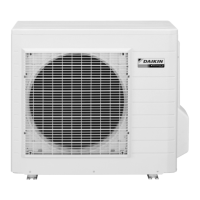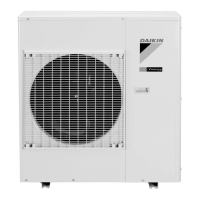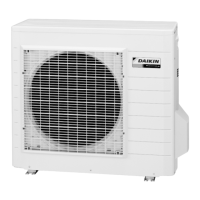Do you have a question about the Daikin RKS50J2V1B and is the answer not in the manual?
Be sure to read the following safety cautions before conducting repair work.
Warnings and cautions for workers when performing repairs.
Warnings and cautions for users regarding equipment installation and maintenance.
Technical specifications for cooling-only operation modes.
Technical specifications for heat pump operation modes.
Determines compressor frequency based on temperature difference and PI control.
Limits operating frequency to prevent indoor heat exchanger freezing during cooling.
Determines frequency upper limit to prevent abnormal high pressure during heating.
Stops compressor operation based on outdoor temperature and heat exchanger temperature.
Control functions of the electronic expansion valve in various operation modes.
Detection of sensor malfunctions, particularly thermistors.
Detection methods for overcurrent and overload to protect the compressor.
Methods for detecting refrigerant shortage through various parameters.
Troubleshooting indoor unit errors detected by the operation lamp and service monitor LED.
Troubleshooting outdoor unit errors detected by the service monitor LED.
Table of common symptoms, check items, and their corresponding measures.
List of error codes displayed on the remote controller and their descriptions.
Troubleshooting steps for indoor unit PCB abnormalities.
Troubleshooting steps for freeze-up protection or heating peak-cut control issues.
Troubleshooting steps for abnormal fan motor operation or related issues.
Troubleshooting steps for indoor unit thermistor or related abnormalities.
Troubleshooting signal transmission errors between indoor and outdoor units.
Troubleshooting unspecified voltage issues between indoor and outdoor units.
Troubleshooting steps for outdoor unit PCB abnormalities in 20/25/35 class models.
Troubleshooting steps for outdoor unit PCB abnormalities in 42/50 class models.
Troubleshooting steps for OL activation (compressor overload).
Troubleshooting steps for compressor lock issues.
Troubleshooting steps for DC fan lock errors.
Troubleshooting steps for input overcurrent detection.
Troubleshooting steps for four way valve abnormalities.
Troubleshooting steps related to discharge pipe temperature control.
Troubleshooting steps for high pressure control during cooling operation.
Troubleshooting compressor system sensor abnormalities for 20/25/35/42 class units.
Troubleshooting compressor system sensor abnormalities for 50 class units.
Troubleshooting steps for position sensor abnormalities.
Troubleshooting DC voltage/current sensor abnormalities for 20/25/35/42 class units.
Troubleshooting CT or related abnormalities for 50 class units.
Troubleshooting outdoor unit thermistor or related abnormalities.
Troubleshooting steps for electrical box temperature rise issues.
Troubleshooting steps for radiation fin temperature rise issues.
Troubleshooting steps for output overcurrent detection in the inverter DC section.
Methods for detecting refrigerant shortage through various parameters.
Troubleshooting low-voltage or over-voltage detection issues.
Troubleshooting signal transmission errors on the outdoor unit PCB for 50 class units.
Procedure to check for short circuits on the main circuit by measuring resistance.
Be sure to read the following safety cautions before conducting repair work.
Warnings and cautions for workers when performing repairs.
Warnings and cautions for users regarding equipment installation and maintenance.
Technical specifications for cooling-only operation modes.
Technical specifications for heat pump operation modes.
Determines compressor frequency based on temperature difference and PI control.
Limits operating frequency to prevent indoor heat exchanger freezing during cooling.
Determines frequency upper limit to prevent abnormal high pressure during heating.
Stops compressor operation based on outdoor temperature and heat exchanger temperature.
Control functions of the electronic expansion valve in various operation modes.
Detection of sensor malfunctions, particularly thermistors.
Detection methods for overcurrent and overload to protect the compressor.
Methods for detecting refrigerant shortage through various parameters.
Troubleshooting indoor unit errors detected by the operation lamp and service monitor LED.
Troubleshooting outdoor unit errors detected by the service monitor LED.
Table of common symptoms, check items, and their corresponding measures.
List of error codes displayed on the remote controller and their descriptions.
Troubleshooting steps for indoor unit PCB abnormalities.
Troubleshooting steps for freeze-up protection or heating peak-cut control issues.
Troubleshooting steps for abnormal fan motor operation or related issues.
Troubleshooting steps for indoor unit thermistor or related abnormalities.
Troubleshooting signal transmission errors between indoor and outdoor units.
Troubleshooting unspecified voltage issues between indoor and outdoor units.
Troubleshooting steps for outdoor unit PCB abnormalities in 20/25/35 class models.
Troubleshooting steps for outdoor unit PCB abnormalities in 42/50 class models.
Troubleshooting steps for OL activation (compressor overload).
Troubleshooting steps for compressor lock issues.
Troubleshooting steps for DC fan lock errors.
Troubleshooting steps for input overcurrent detection.
Troubleshooting steps for four way valve abnormalities.
Troubleshooting steps related to discharge pipe temperature control.
Troubleshooting steps for high pressure control during cooling operation.
Troubleshooting compressor system sensor abnormalities for 20/25/35/42 class units.
Troubleshooting compressor system sensor abnormalities for 50 class units.
Troubleshooting steps for position sensor abnormalities.
Troubleshooting DC voltage/current sensor abnormalities for 20/25/35/42 class units.
Troubleshooting CT or related abnormalities for 50 class units.
Troubleshooting outdoor unit thermistor or related abnormalities.
Troubleshooting steps for electrical box temperature rise issues.
Troubleshooting steps for radiation fin temperature rise issues.
Troubleshooting steps for output overcurrent detection in the inverter DC section.
Methods for detecting refrigerant shortage through various parameters.
Troubleshooting low-voltage or over-voltage detection issues.
Troubleshooting signal transmission errors on the outdoor unit PCB for 50 class units.
Procedure to check for short circuits on the main circuit by measuring resistance.
| Model | RKS50J2V1B |
|---|---|
| Category | Air Conditioner |
| Type | Split System |
| Cooling Capacity | 5.0 kW |
| Heating Capacity | 5.8 kW |
| Energy Efficiency Ratio (EER) | 3.21 |
| Seasonal Energy Efficiency Ratio (SEER) | 6.10 |
| Coefficient of Performance (Heating) | 3.61 |
| Refrigerant | R32 |
| Outdoor Unit Dimensions (W x H x D) | 845 x 595 x 300 mm |
| Weight (Indoor Unit) | 9.5 kg |
| Power Supply | 220-240 V, 50 Hz |
| Outdoor Unit Noise Level | 49 dB(A) |











